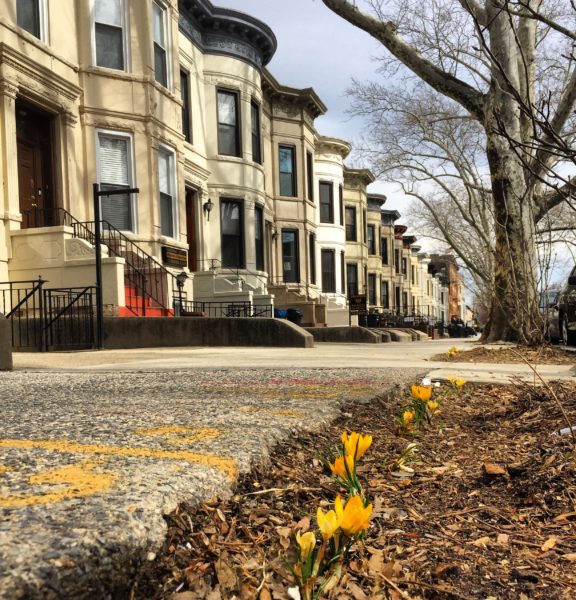Request for Evaluation: Bay Ridge Parkway

Statement of Significance
Bay Ridge Parkway, known as “Doctors’ Row,” serves as an unofficial gateway to Bay Ridge, as it is a major thoroughfare within the neighborhood. The proposed historic district includes a total of 53 properties located between 4th and 5th Avenues in Brooklyn. The 400 block of Bay Ridge Parkway is the only known street–avenue to avenue—to have limestone rowhouses on both sides of the street in the Bay Ridge neighborhood, which lends a strong sense of place. This homogeneity is due to the buildings’ construction by one developer, the Bay Ridge Development Company in 1899, although the homes were still being advertised for sale in the Brooklyn Daily Eagle as late as 1908. While there was a massive amount of construction occurring in Bay Ridge at the turn of the century, it is unusual in the neighborhood to find a uniform swath of homes avenue to avenue developed in the same style by one builder; most Bay Ridge blocks vary stylistically in their architecture. Although an exact date of construction has not been determined, a resident of the block recalls an original deed from 1899. Further, Department of Buildings filings reveal alterations and plumbing permits from as early as 1901, and the block was discovered on a 1905 Bromley map as being completely built at that time.
The homes’ development is representative of Bay Ridge’s transformation from suburban resort enclave to a middle-class urban neighborhood as we know it today. The building stock here, and in much of Bay Ridge, is a direct result of the construction boom which immediately followed advancements in transportation to the area, including the 3rd, 4th and 5th Avenue trolley lines and later, the Brooklyn Rapid Transit subway. Although the 4th Avenue subway line did not open in Bay Ridge until 1916, real estate ads for this block advertised the arrival of the subway at 75th Street to help sell the homes. (The R line, as built, has an entrance two blocks away at 77th Street.) Historic atlases included in this packet demonstrate the neighborhood’s vast development from detached wood frame houses and undeveloped blocks in 1898 compared with the area in 1905, where most blocks have been filled in by masonry rowhouses. Collectively, the swath of homes on Bay Ridge Parkway represents early transit-related speculative development in the neighborhood at the turn of the 20th century. When compared to historic real estate ads, the homes appear much the same today as they did over a century ago.
This dignified block consists of bow-fronted limestone Neo-Renaissance rowhouses which are unusually set back from the street. The effect of the set back is dramatized by the Parkway’s wider street width, and the houses are screened behind attractive plantings. The buildings retain a high degree of architectural integrity, including all houses retaining original cornices and carved stonework façade details such as lintels, sills and door surrounds; many stoops with original ironwork; stained glass transoms; carved stone panels and many original wooden, double doors. The south side of the street’s homes retain carved wooden colonette door surrounds with leaded glass sidelights and transoms.
The block’s unofficial title of “Doctors’ Row” is due to the large presence of medical offices in the garden levels of the homes. This unique identity as a mixed-use residential block bolsters the importance of the block’s recognition and destination within the community, as office or other uses are not found on residential blocks in the neighborhood, but rather on the avenues. This identity has lasted nearly 70 years, as many Certificates of Occupancy reveal doctors’ offices on this block in the early 1950s. It was common for doctors to have their practices on the garden level and keep residence in the upper floors of the buildings.
Finally, there are five brick Neo-Renaissance rowhouses on the south side of Bay Ridge Parkway which were developed some time after 1905 and therefore separate from the Bay Ridge Development Company’s limestones. Despite this difference, the houses were designed and built to be harmonious with the existing block and for this reason are proposed to be included in the historic district.



